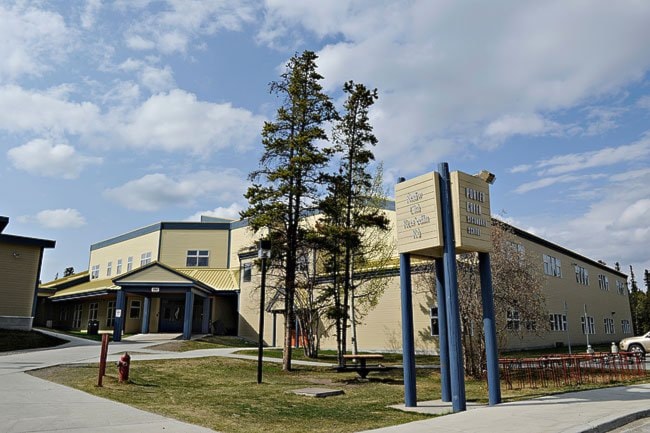Porter Creek Secondary is the territory’s biggest dunce in the latest Fraser Institute school ranking survey.
That, in itself, is not a problem, said the institute’s Peter Cowley.
The problem is that Porter Creek has been performing poorly for years, he said.
The high school is ranked 209 out of 274 schools in the most recent report card for the West Coast.
“The question becomes, why does it just keep hanging down there in the bottom with Prince Rupert and Cariboo-Chilcotin?” said Cowley. “Why is it constantly mired in a sort of mediocre result?
“And more importantly, what does that say about the capacity of the people that operate Porter Creek to effect improvement. It looks like it’s not happening.”
The lead author of the region’s education report card says Department of Education officials and teachers should find solutions, not just assign blame.
If students come from broken or impoverished homes, do not have decent role models, do not have a secure place to live, are not well fed and have little to keep them from drugs and violence - those are challenges for the school system as much as they are challenges for the families, communities and individuals themselves, he said.
“I’m not sure there’s a great deal of evidence to suggest that they’re well trained, even in a general sense, with regard to how to teach and how to operate a classroom,” said Cowley. “But beyond that, I’d be very surprised to hear ... that (Porter Creek Secondary School) is populated by a staff of teachers and administrators who are particularly trained in overcoming the challenges that those kids face.”
And this is not asking too much, he said.
Cowley brings up the example of the Frederick Douglass Academy in New York City’s inner-city Harlem.
This public middle and high school has two main, well-known goals: every student will graduate and every graduate will be eligible for any post secondary program of their choice, said Cowley.
“Not because they’re black, not because they’re poor, not because there is no male role model in the family, not because they don’t know where they’re going to sleep tonight, not because they have to pass through two gang territories,” said Cowley. “But because they’re qualified.”
The point is that administrators and teachers at Porter Creek Secondary need to look outside the box and out of the territory, for examples of how to deal with the challenges students face, he said.
The Education Department’s doing that, said Judith Arnold, director of student achievement and systems accountability.
“We look at best practice, not only outside of Yukon, but from BC and across Canada,” said Arnold, from Old Crow, where she was conducting the second round of internal school reviews.
“Yes, the school has a role in it, the community has a role in it, the department has a role in it. One of the key pieces is, how do we work together to do it?”
This round of school reviews is new. While Yukon schools have been setting goals for years, this year, for the first time, they are using “evidence-based monitoring” and are being reviewed by the department.
“It takes time to improve results,” said Arnold.
But some parents are concerned and are tired of waiting.
“When is someone at the Department of Education going to take accountability for the persistent failure for these numbers to improve?” said Keith Halliday, a former member of the FH Collins and Whitehorse Elementary school councils.
“Everybody has to be involved - the parents, the communities, the education system. But I think, given the millions of dollars we’ve spent on the Department of Education head office over the last five years, we should be expecting to see those results improve.
“Other places that have very challenging demographics have seen dramatic improvements by well-managed, educational authorities. And that’s what we’re not seeing in the Yukon. And it’s really a shame.”
According to the department’s own annual report for 2009/10, language test scores for Grade 9 students have stayed between 62.5 per cent and 59.2 per cent for the past nine years.
This test, like those also administered in Grades 3 and 6, are developed by a group called Western and Northern Canadian Protocol, and teachers put the questions together.
“It’s very important that those scarce resources, that are being funneled into this or that, are actually paying off - that they are addressing the actual issues that have, in the past, meant that the kids were learning at relatively lower levels,” said Cowley. “We’ve got to be sure that the next time an additional dollar goes to Porter Creek, it is going there to change something that is actually affecting their results now.
“Kids’ futures depend on that honesty.”
Vanier Catholic Secondary School was the highest rated in the territory at 96 out of 247. FH Collins came in at 135.
Watson Lake Secondary School (8-12), St. Elias Community School (K-12) in Haines Junction, Del Van Gorder (K-12) in Faro, Eliza Van Bibber (K-12) in Pelly Crossing, J.V. Clark (K-12) in Mayo, Tantalus (K-12) in Carmacks and Robert Service (K-12) in Dawson City were not included in the report because of their small populations.
Contact Roxanne Stasyszyn
at roxannes@yukon-news.com
